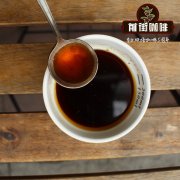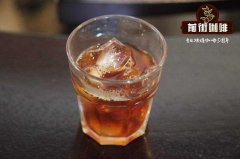What is the growing environment of Moka Yishi Mary in Yemen? What is the mocha tree? How to use v60

Professional coffee knowledge exchange more coffee bean information please follow the coffee workshop (Wechat official account cafe_style)
What is the growing environment of Moka Yishi Mary in Yemen? What is the mocha tree? How to brew mocha with v60 filter cup?
The special sun treatment method of Mocha in Yemen is to manually harvest mature and dry coffee beans on trees and directly place the whole coffee in a special coffee drying field or in its own compacted soil front yard. During the sun exposure and Taiwan grain drying farms generally use wooden rakes to keep even, about 20 days after coffee drying, the outer pulp and peel are removed from the coffee beans. The common Yemeni mocha is Sanani, Matari, both named after the producing area, Ismaili is named after the coffee tree species in the Hirazi producing area is the least productive and most expensive Yemeni mocha. The most correct spelling of mocha coffee should be Al-Mahka, which is the Arabic spelling, but in the end, what you see on the sack is the correct spelling of Mocca or Mocha, regardless of some naming and spelling trivialities, Yemeni coffee is the most unique and expensive coffee in the world, the overall style of [wild] or [natural] coffee flavor is extremely complex, for some people it is spicy and pungent. But anyway, you have to try it sometime.
Main coffee producing areas: Mattari Matali, Hirazi Hilazi, Haimi Haimi, Saihi Saihi, Ismaili Yishi Mary, Sharasi Salazi, Dhamari Damali, Rimy Remy
The Ismaili producing area of Yemen is also the most traditional coffee tree species. The Hirazi producing area of Yishimari is located in the mountains of 6500-8000 feet above sea level. The way of obtaining coffee is still the same as in ancient times. Wild coffee grows naturally on the trees and matures without using any fertilizers and pesticides. After drying on the trees, the coffee falls naturally and is dried directly by the sun on the mud. Coffee farmers just bring coffee home from the ground and grind off the dried peel and pulp with a stone mill, which is the most primitive method of drying beans. Yishi Mary in Yemen is still produced in this way. Yishi Mary (Ismaili) has a large gap in bean size (with pictures on the blog), which has something to do with her natural wild on narrow terraces with steep rainfall and poor ridges and insufficient sunshine. It is such unique and difficult natural growth conditions that make her an irreplaceable position in the coffee world.
Tree species: more than 10 special native mocha species, introduced from Ethiopia and introduced from Hara, Ethiopia, the native region of Arabica in the 6th century or earlier. Yemen is the first coffee country to grow since Ethiopia.
Yemeni coffee is not easy to grow and harvest. Most farmland grows Qat grass, which is said to have a mild and refreshing effect. This plant absorbs water from the ground and breaks the underground aquifer. Growing coffee is different. I hope some changes can be made to make farmers stop planting cat grass.
The end of shallow baking (City): open the coffee sack and there is a mysterious smell of Ceylon black tea, the coffee has the faint aroma of sweet-scented osmanthus after grinding, the fragrance of jasmine tablets after brewing, the taste is very clean and smooth, the sweetness of dried longan and honey brew lasts for a long time, and the sweetness of chrysanthemum or chamomile constantly turns to cause the floral aroma of nasal cavity. It is recommended to brew it 14 days after roasting or use it as an ice drop coffee. The complex fermented flower wine is the best.
Re-baking second explosion start (Full City): the end of 45 seconds is the deepest baking degree of Yemeni Yishima, the dry aroma of fermented black tea becomes strong and unrestrained, the special aroma of ginseng fennel and houttuynia cordata, the taste of mild, smooth and sweet taste, the sweet smell of fermented fruit wine in the sweetness of peach, and the sweetness of Yishima honey plum wine. It is recommended to cook 72 hours after baking, let the restless volatilization bring out the strong maple syrup flavor of Yishi Mary and the oily cocoa sweetness thoroughly, making the whole taste rich and bright.
Mocha is the export port of Yemeni coffee, because it is difficult to name all the tiny sub-producing areas in the history of the coffee trade, even though the coffee produced by these small producing areas is indeed very good. So the sun beans near the place of export, including East Africa, were exported from the port of Mocha to all parts of the world in the early days, and now the port of Mocha has long been silted up and disappeared. Many Ethiopian sun beans also name themselves mocha, such as Haramoka, which we know well. I think this is because its flavor has something in common with Yemeni coffee.
Yemen is probably the first country in the world to use coffee as a cash crop. It is said that coffee was introduced by Muslim Sufi pilgrims from Ethiopia in the 6th century. Yemeni coffee culture is different from other regions. Exporters do not buy directly from the farm, but from the middle market dealers, and the coffee received by the local market merchants contains pods. The whole sun-dried coffee cherry is usually stored in the cellar, and the special flavor of Yemeni coffee that the world loves may come from their ancient way of trade. Yemeni coffee farmers have not suffered from trading through the market. The main reason is that the local coffee cultivation land is limited, coupled with high latitudes and limited water resources, its production is very scarce, and the demand for Yemeni coffee is very high. Keep the price of Yemeni coffee high.
Planting shading methods: wild planting, shaded but no written records, coffee is grown on terraces
Qianjie recommended cooking:
Filter cup: Hario V60
Water temperature: 88 degrees
Degree of grinding: small Fuji degree of grinding 4
Cooking methods: the ratio of water to powder is 1:15, 15g powder, the first injection of 25g water, 25 s steaming, the second injection to 120g water cut off, waiting for the powder bed water to half and then water injection, slow water injection until 225g water, extraction time about 2:00
Analysis: using three-stage brewing to clarify the flavor of the front, middle and back of the coffee. Because the V60 has many ribs and the drainage speed is fast, it can prolong the extraction time when the water is cut off.
Important Notice :
前街咖啡 FrontStreet Coffee has moved to new addredd:
FrontStreet Coffee Address: 315,Donghua East Road,GuangZhou
Tel:020 38364473
- Prev

What are the characteristics of coffee beans from Mocha Ishmi? What is mocha coffee?
Professional coffee knowledge exchange More coffee bean information Please pay attention to coffee workshop (Weixin Official Accounts cafe_style)[Traditional ancient method sun] Mocha Yi Shi Mary production area coffee beans characteristics? What are mocha beans? Some say it's the oldest tree, some say it's the growing area. In Haraazi, Yemen, the local market offers spices, tea, qat, coffee.
- Next

[boutique single coffee beans] the flavor of bourbon coffee beans from Fog Garden Farm in Antigua, Guatemala.
For more information on coffee beans, please follow the coffee workshop (Wechat official account cafe_style) [boutique coffee beans] the flavor and taste characteristics of bourbon coffee beans from Wuyuan Farm in Antigua, Guatemala? Antigua (Antigua), a first-rate planting area, has volcanic soil and the soil quality of the Tarrazu region of Costa Rica.
Related
- Detailed explanation of Jadeite planting Land in Panamanian Jadeite Manor introduction to the grading system of Jadeite competitive bidding, Red bid, Green bid and Rose Summer
- Story of Coffee planting in Brenka region of Costa Rica Stonehenge Manor anaerobic heavy honey treatment of flavor mouth
- What's on the barrel of Blue Mountain Coffee beans?
- Can American coffee also pull flowers? How to use hot American style to pull out a good-looking pattern?
- Can you make a cold extract with coffee beans? What is the right proportion for cold-extracted coffee formula?
- Indonesian PWN Gold Mandrine Coffee Origin Features Flavor How to Chong? Mandolin coffee is American.
- A brief introduction to the flavor characteristics of Brazilian yellow bourbon coffee beans
- What is the effect of different water quality on the flavor of cold-extracted coffee? What kind of water is best for brewing coffee?
- Why do you think of Rose Summer whenever you mention Panamanian coffee?
- Introduction to the characteristics of authentic blue mountain coffee bean producing areas? What is the CIB Coffee Authority in Jamaica?

